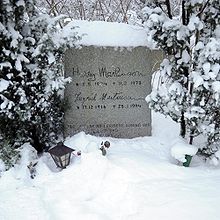Harry Martinson: Difference between revisions
No edit summary |
m →Life |
||
| Line 40: | Line 40: | ||
One of his most famous works is the poetic cycle ''[[Aniara]]'', which is a story of the space craft ''Aniara'' that during a [[spaceflight|journey through space]] loses its course and subsequently floats on without destination. The book was published in 1956 and became [[Aniara (opera)|an opera]] in 1959 composed by [[Karl-Birger Blomdahl]]. The cycle has been described as "an epic story of man's fragility and folly". |
One of his most famous works is the poetic cycle ''[[Aniara]]'', which is a story of the space craft ''Aniara'' that during a [[spaceflight|journey through space]] loses its course and subsequently floats on without destination. The book was published in 1956 and became [[Aniara (opera)|an opera]] in 1959 composed by [[Karl-Birger Blomdahl]]. The cycle has been described as "an epic story of man's fragility and folly". |
||
He took his life on 11 February 1978 at the [[Karolinska University Hospital]] in Stockholm by performing Seppuku with a pair of scissors. |
He took his life on 11 February 1978 at the [[Karolinska University Hospital]] in Stockholm by performing [[Seppuku]] with a pair of scissors. |
||
The 100th anniversary of Martinson's birth was celebrated around Sweden in 2004. |
The 100th anniversary of Martinson's birth was celebrated around Sweden in 2004. |
||
Revision as of 04:46, 25 May 2013
This article needs additional citations for verification. (June 2009) |
Harry Martinson | |
|---|---|
 Harry Martinson in the early 1940s. | |
| Born | 6 May 1904 Jämshög, Sweden |
| Died | 11 February 1978 (aged 73) Stockholm, Sweden |
| Notable awards | Nobel Prize in Literature 1974 Shared with Eyvind Johnson |
| Spouse | Moa Martinson |
Harry Martinson (6 May 1904 – 11 February 1978) was a Swedish sailor, author and poet. In 1949 he was elected into the Swedish Academy. He was awarded a joint Nobel Prize in Literature in 1974 together with fellow Swede Eyvind Johnson. The choice was very controversial, as both Martinson and Johnson were members of the academy and had partaken in endorsing themselves as laureates.
He has been called "the great reformer of 20th century Swedish poetry, the most original of the writers called 'proletarian'."[1]
Life
Martinson was born in Jämshög, Blekinge County in south-eastern Sweden. At a young age he lost both his parents whereafter he was placed as a foster child (Kommunalbarn) in the Swedish countryside. At the age of sixteen Martinson ran away and signed onto a ship to spend the next years sailing around the world visiting countries such as Brazil and India.

A few years later lung problems forced him to set ashore in Sweden where he travelled around without a steady employment, at times living as a vagabond on country roads. In the city of Malmö, at the age of 21, he was arrested for vagrancy.
In 1929, he debuted as a poet. Together with Artur Lundkvist, Gustav Sandgren, Erik Asklund and Josef Kjellgren he authored the anthology Fem unga (Five Youths),[2] which introduced Swedish Modernism. His poetry combined an acute eye for, and love of nature, with a deeply felt humanism. His popular success as a novelist came with the semi-autobiographical Nässlorna blomma (Flowering Nettles) in 1935, about hardships encountered by a young boy in the countryside. It has since been translated into more than thirty languages.
From 1929 to 1940, he was married to Moa Martinson, whom he met through a Stockholm anarchist newspaper Brand.[1] He travelled to the Soviet Union in 1934.[1] He and Moa were divorced due to her criticism of his lack of political commitment.[1] Moa became a writer; Harry married Ingrid Lindcrantz (1916-1994) in 1942.[1]
One of his most famous works is the poetic cycle Aniara, which is a story of the space craft Aniara that during a journey through space loses its course and subsequently floats on without destination. The book was published in 1956 and became an opera in 1959 composed by Karl-Birger Blomdahl. The cycle has been described as "an epic story of man's fragility and folly".
He took his life on 11 February 1978 at the Karolinska University Hospital in Stockholm by performing Seppuku with a pair of scissors.
The 100th anniversary of Martinson's birth was celebrated around Sweden in 2004.
Controversy
The joint selection of Eyvind Johnson and Martinson for the Nobel Prize in 1974 was very controversial as both were on the Nobel panel. Graham Greene, Saul Bellow and Vladimir Nabokov were the favoured candidates that year.
The sensitive Martinson found it hard to cope with the criticism in the 1970s following his award, and committed suicide[1][3] with a pair of scissors.
Bibliography
Titles in English where known.
Novels
|
Essays
|
Poems
|
Radio plays
|
Stage play
|
Psalms
|
References
- ^ a b c d e f "Harry Martinson" (in French). Retrieved 27 March 2012.
- ^
Kumm, Bjorn (12-Dec-1991). "Obituary: Artur Lundkvist". The Independent. London. p. 13.
{{cite news}}:|access-date=requires|url=(help); Check date values in:|accessdate=and|date=(help); Cite has empty unknown parameter:|coauthors=(help) - ^ IMDb
External links
- All articles with faulty authority control information
- 1904 births
- 1978 deaths
- People from Olofström Municipality
- Writers from Blekinge
- Swedish science fiction writers
- Members of the Swedish Academy
- Nobel laureates in Literature
- Suicides by sharp instrument in Sweden
- Swedish-language writers
- Writers who committed suicide
- Swedish Nobel laureates
- Dobloug Prize winners
